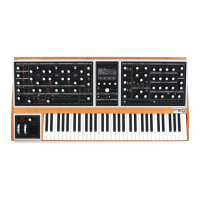50
LOW FREQUENCY OSCILLATORS (Continued)
DELAY TIME (OFF, 0ms to 10s)
This parameter sets up a timing delay, or interval, before the LFO signal begins.
FADE IN TIME (OFF, 0ms to 10s)
This parameter controls how much time is need for the LFO intensity to rise from zero to its maximum
level. The Fade In time begins after the Delay Time is complete.
FADE OUT TIME (OFF, 0ms to 10s)
This parameter controls how much time is need for the LFO intensity to fall from its maximum level to
0. The Fade Out time begins after the Delay Time and the Fade-In stages are complete.
REPEATS (INFINITE, 1 - 32)
Setting an integer value for this parameter will specify an exact number of full cycles that will be
completed by the LFO, after Note On. Once that value has been reached, the LFO will wait for the next
note-on command and begin all over.
TIP: The DELAY TIME, FADE IN TIME, FADE OUT TIME, and REPEATS parameters can be used together to
make some exciting performance modulation happen as part of the sound design of your Preset, without
needing to use a free hand to operate a modulation controller. For example, you could have an LFO wait 2
seconds to fade in and then fade out on a wide vibrato that is applied 8 times to a sustained note(s).
SMOOTHING (0% to 100%)
By selecting smoothing, a single-pole (-6 dB per Octave) low-pass lter is applied to the LFO wave
shape. As the Smoothing value is increased, the Cutoff Frequency is lowered, limiting the changes in
the LFO signal. Smoothing is most noticeable at slower LFO rates, and with the S-H / Noise and Pulse
wave shapes.
VCA AND OUTPUT
The VCA module and the OUTPUT module may appear to be similar, but their functions are quite
different. In short, the panel controls of the VCA module consist of a LEVEL knob and a PAN knob.
Their function affects only the active Synth(s) that has been selected using the Panel Focus buttons:
SYNTH 1, SYNTH 2, and SYNTH 3. Their purpose is to set the level and panning of the active Synth
within the stereo MAIN OUT and/or SUB OUT mixes. The panel controls of the MASTER OUT module,
on the other hand, are used to adjust the listening level of the entire Moog One, and are unaffected
by the loading of Presets and Timbres. Both modules are equipped with a MORE button that reveals a
second parameter layer, where their differences may become more apparent.
VCA
VCA stands for Voltage Controlled Amplier. Before it can be heard, the sound being created by
Moog One must pass through an amplier circuit to bring it to an appropriate output level. This
amplier circuit is under voltage control, meaning that the amplier parameters can be controlled
via a modulation source, and are saved as part of the active Synth.

